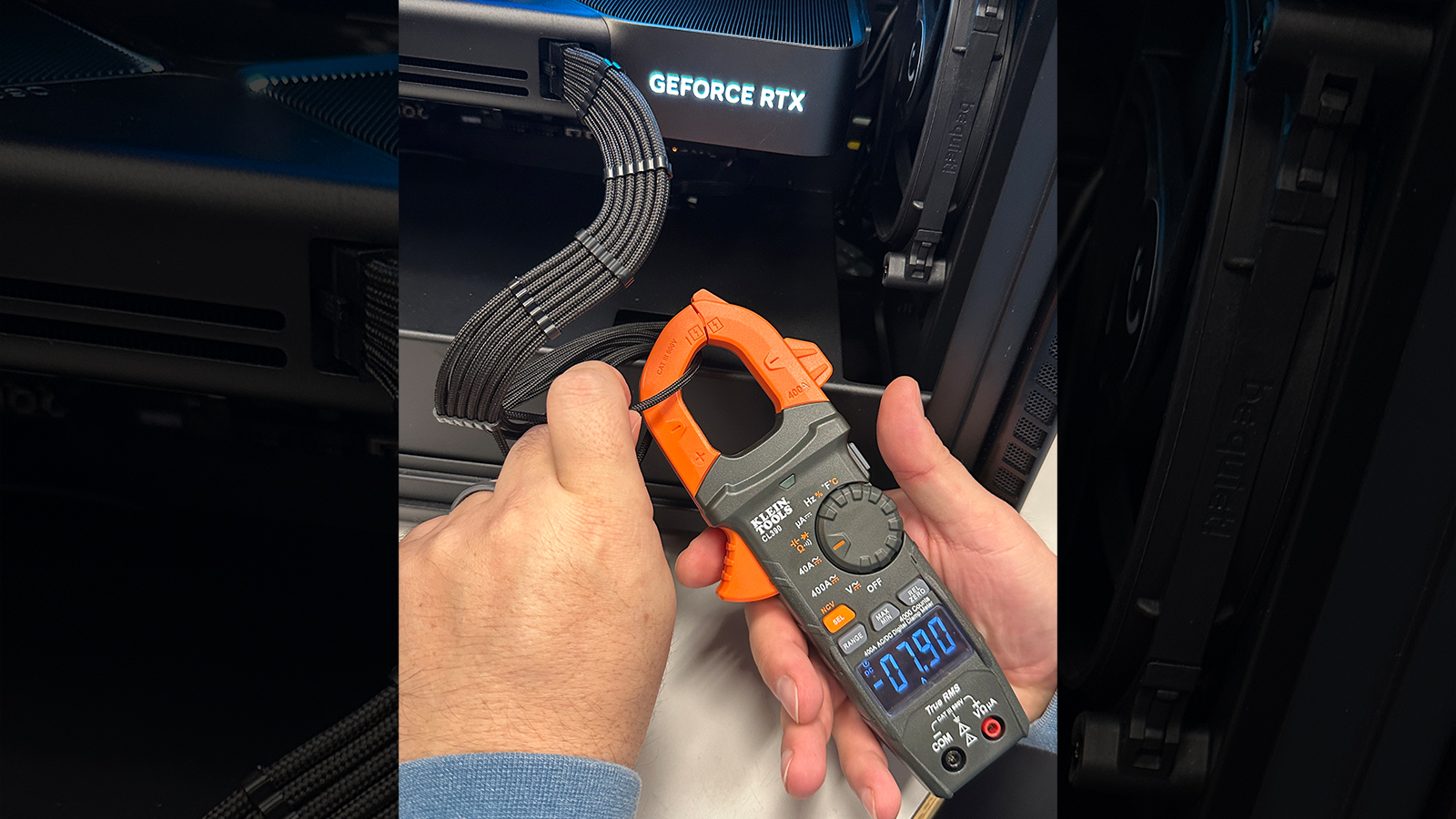RTX 5090 cable melting issues haven't been replicated — testers assess various power supplies and cable types
Falcon Northwest has been lucky, so far.

PC integrator Falcon Northwest said on X that it could not replicate the melting RTX 5090 FE power connector issue, even after testing multiple RTX 5090 Founders Edition builds using different power supplies and cable types. It has even run several days of “closed chassis burn-in” and found that all temperatures and amperages stayed within their nominal range.
Popular YouTuber Der8auer had one of the cables of his RTX 5090 GPU overheat to 150 degrees Celsius when it was found to be drawing a current of 22 amps—more than double its 9.5-amp rating. This contradicts what Nvidia assured us, saying that the melting cable incidents with the RTX 4090s are unlikely to happen now.
However, this doesn’t mean that the overheating issue doesn't occur at all. One X user pointed out that Der8auer had connected and disconnected the cable. In contrast, Falcon Northwest would likely not have done that if they had tested customer units before shipment.
HUGE respect for @der8auer 's testing, but we're not seeing anything like his setup's results.We tested many 5090 Founder's builds with multiple PSU & cable types undergoing days of closed chassis burn-in.Temps (images in F) & amperages on all 12 wires are nominal. pic.twitter.com/oDPIUSjOOfFebruary 11, 2025
Another YouTuber, JayzTwoCents, said on X that the 12VHPWR cable on his RTX 5090 GPU was much warmer than the one he used in his RTX 4090. While the temperatures he recorded were still within spec, he wondered whether one cable pulling more power than the others would be a much more widespread issue.
One user theorized the problem could be with the cable or GPU connection, as the RTX 5090 FE’s right-angle connector combines six voltage wires into one single pin. Because of that, there’s no way for the GPU to distribute the voltage load evenly across all the pins. Since electrical current will always take the path of least resistance, imperfections in the connection or cable itself might have caused the overheating and subsequent melting. However, this is still just a theory that must be tested in lab conditions to ensure its validity.
The FE's right angle connector on the PCB combines all 6 voltage wires into one single pin. There's no way for the board itself to distribute the load across the 6 12V wires, current always takes the path of least Resistance. pic.twitter.com/CakKSlKLA6February 11, 2025
Some manufacturers have taken matters into their own hands to avoid a repeat of the melting RTX 5090 connector saga. MSI put yellow tips into its 16-pin power adapter to ensure PC builders knew when the connector was fully inserted into the GPU. Zotac implemented a Safety Light feature that indicates if the power cable is fully seated in the graphics cards and prevents it from turning on if not.
These efforts would likely solve the issue of melting connectors due to loose connections, especially on the GPU side. However, if the problem is the uneven splitting of electrical current causing one or more cables to overheat, we have a deeper issue that might require a rethink of how the RTX 5090 gets power from the power supply.
Get Tom's Hardware's best news and in-depth reviews, straight to your inbox.

Jowi Morales is a tech enthusiast with years of experience working in the industry. He’s been writing with several tech publications since 2021, where he’s been interested in tech hardware and consumer electronics.
-
Shiznizzle Popular YouTuber Der8auer had one of the cables of his RTX 5090 GPU overheat to 150 degrees Celsius when it was found to be drawing a current of 22 amps—more than double its 9.5-amp rating.Reply
False. Watch the video. He clearly stated that it was not his card -
TheyStoppedit This video right here tells you everything you need to know. I have been saying for the last 3 years that this was never ever a user error issue. It never has been and it never will be. It is patently and objectively a design flaw. That is just a hard and fast fact. There's no mistaking that. There never was. The standard 8-pin never had this problem. Its been a reliable standard for years. Suddenly, new cable melts. NVidia comes out: "Oh, you're plugging it in wrong" ..... like all of us who spent 15+ years plugging in 8-pin cables suddenly forgot how to plug in a cable. This is straight forward logic. I have been saying it for 3 years now and I will say it again: NVidia, its time to own your mistake, stop blaming the user, and fix the problem. But hey, blaming the user is cheaper than fixing the problem. Hats off to AMD for sticking to the 8-pin. Merry christmas.....Reply
kb5YzMoVQywView: https://www.youtube.com/watch?v=kb5YzMoVQyw -
Kashmir35 If everything is brand new and works perfectly, then there should be no problem. Except it's DIY market, you will have wear and tear, a multitude of configurations and of course you will have ppl using cheap PSU with their 5090 also (it was not the case here but just saying, it could happen). And it is the engineer duty to account for all of that. There is no safety margin, no room for error, now you have to make sure your cable is brand new or obviously you are the one to blame. Should we change our cables every 2 years now Nvidia? The company failed miserably to deliver a safe product and should have a lawsuit on its hand. The path of least resistance thing that can draw all the power on just one cable, it's electricity 101, I feel I learned this in middle school.Reply -
Jame5 Reply
My thought exactly after that explainer video. The fact that they removed any and all load balancing circuitry from the cards and just made all 6 12v wires dump into a single pin is kind of nuts. The 3090 TI 12vHPWR design, and all the 8-pin PCIe designs don't do that. They have load balancing circuitry.TheyStoppedit said:This video right here tells you everything you need to know. I have been saying for the last 3 years that this was never ever a user error issue. It never has been and it never will be. It is patently and objectively a design flaw. That is just a hard and fast fact. There's no mistaking that. There never was. The standard 8-pin never had this problem. Its been a reliable standard for years. Suddenly, new cable melts. NVidia comes out: "Oh, you're plugging it in wrong" ..... like all of us who spent 15+ years plugging in 8-pin cables suddenly forgot how to plug in a cable. This is straight forward logic. I have been saying it for 3 years now and I will say it again: NVidia, its time to own your mistake, stop blaming the user, and fix the problem. But hey, blaming the user is cheaper than fixing the problem. Hats off to AMD for sticking to the 8-pin. Merry christmas.....
kb5YzMoVQywView: https://www.youtube.com/watch?v=kb5YzMoVQyw
It's a dumb design, and unless they re-implement the actual load balancing circuitry on the power input pins, it will continue to be a dumb design.
*Edit: Could this still be caused by not all of the pins being seated correctly? Yes. But that's kind of the point. Older power delivery systems wouldn't let the card turn on if the parallel power inputs weren't all working. The new 12VHPWR/12V-2x6 solution that nvidia introduced on the 4000 series doesn't do that. It just takes the power across any of the pins that are connected, leading to the problems here.
Honestly makes me hope the 5070 Ti solutions still come with 2x 8-pin inputs. -
valthuer ReplyTheyStoppedit said:This video right here tells you everything you need to know. I have been saying for the last 3 years that this was never ever a user error issue. It never has been and it never will be. It is patently and objectively a design flaw. That is just a hard and fast fact. There's no mistaking that. There never was. The standard 8-pin never had this problem. Its been a reliable standard for years. Suddenly, new cable melts. NVidia comes out: "Oh, you're plugging it in wrong" ..... like all of us who spent 15+ years plugging in 8-pin cables suddenly forgot how to plug in a cable. This is straight forward logic. I have been saying it for 3 years now and I will say it again: NVidia, its time to own your mistake, stop blaming the user, and fix the problem. But hey, blaming the user is cheaper than fixing the problem. Hats off to AMD for sticking to the 8-pin. Merry christmas.....
kb5YzMoVQywView: https://www.youtube.com/watch?v=kb5YzMoVQyw
Ok, we got this, you think it’s an Nvidia error. Now will you please stop writing the same comment? -
YSCCC And somehow I remember right when 4090 debuted some ppl mocked the RDNA3 cards using clumsy 3x 8pin and praised the new shiny standard, now 2 years passed with the 3.1 standard and it still goes through the melting gate to thing againReply -
Gururu Well I guess it would be easier to perform a shunt resistor mod on the card for overclocking...Reply -
JamesJones44 Reply
Assuming the video is correct, then it seems more like an issue with an implementation of the phases than the connector or cable of the 12V-2x6 spec. Thus AMD sticking with 8-pins is potential moot.TheyStoppedit said:But hey, blaming the user is cheaper than fixing the problem. Hats off to AMD for sticking to the 8-pin. Merry christmas -
The Historical Fidelity Reply
My favorite part of the video is that Nvidia had an adequate solution in the 3000 series. I still don’t understand why, with all the melting issues of the 4000 series, they don’t switch back to the 3000 series solution.TheyStoppedit said:This video right here tells you everything you need to know. I have been saying for the last 3 years that this was never ever a user error issue. It never has been and it never will be. It is patently and objectively a design flaw. That is just a hard and fast fact. There's no mistaking that. There never was. The standard 8-pin never had this problem. Its been a reliable standard for years. Suddenly, new cable melts. NVidia comes out: "Oh, you're plugging it in wrong" ..... like all of us who spent 15+ years plugging in 8-pin cables suddenly forgot how to plug in a cable. This is straight forward logic. I have been saying it for 3 years now and I will say it again: NVidia, its time to own your mistake, stop blaming the user, and fix the problem. But hey, blaming the user is cheaper than fixing the problem. Hats off to AMD for sticking to the 8-pin. Merry christmas.....
kb5YzMoVQywView: https://www.youtube.com/watch?v=kb5YzMoVQyw -
Tonet666 I've noticed that no other brand than MSi is using fuses on the 12V from the PSU. I wonder why.Reply